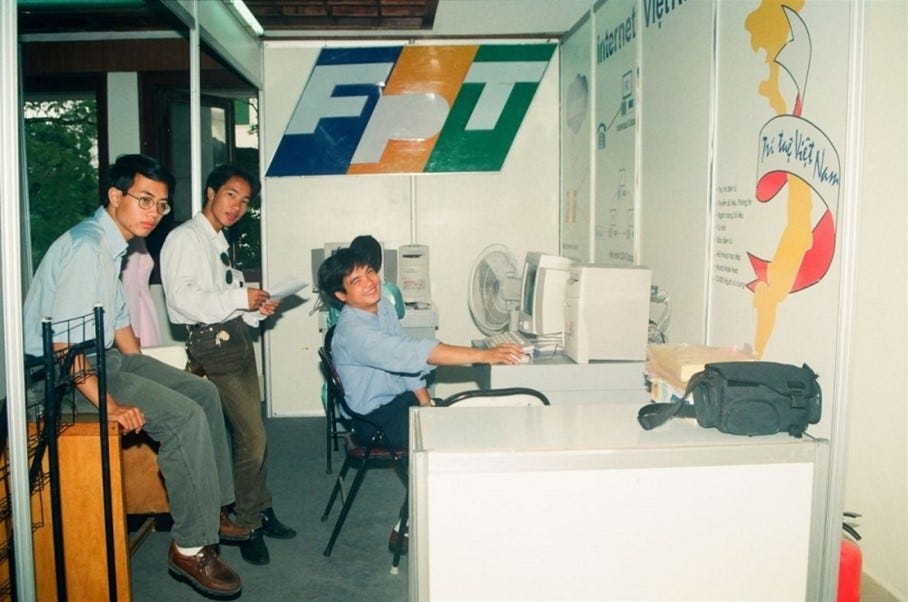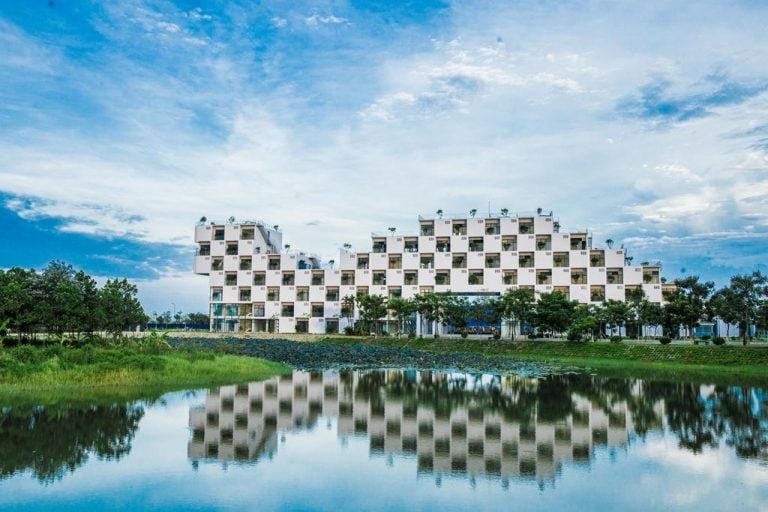'Compounders': The Ultimate 'Lazy' Investment Choice?
Finding 'compounder' investments and sticking with them, and a case study of a Vietnamese ICT 'compounder'
This Insight is not investment advice and should not be construed as such. Past performance is not predictive of future results. Fund(s) managed by Seraya Investment may be long or short securities mentioned in this Insight. Any resemblance of people or companies mentioned in this Insight to real entities is purely coincidental. Our full Disclaimer can be found here.
This Insight is an extract adapted from the Panah Fund letter to investors for Q3 2018.1
In previous reports, we have praised the virtues of ‘compounders’.2 At Seraya, we define a compounder as a company which generates strong cash flow, and which is able to continue reinvesting this cash flow at high rates of return over the long term.
Investing in the equity of compounder companies allows one to take advantage of the ‘law of nature’ by which an initial investment amount can be multiplied at high rates of return over the long haul. Indeed, so long as a company can continue to invest in projects which pay sufficiently attractive rates of return (well above its cost of capital), then long-term equity investors should prefer to receive no dividends and instead have their share of earnings reinvested by company management.
Investing in compounders that trade at low valuation multiples is the ‘holy grail’ of investing, as this simultaneously provides a margin of safety and also creates the potential for a valuation uplift.
If one is lucky enough to find a true compounder of this sort, the sensible thing to do – which naturally is easier said than done – is to stay invested for as long as the company’s returns can be maintained. Indeed, this is why compounders might just be the ultimate ‘lazy’ investment choice! Just stay invested.
Of course, in reality it is necessary to turn over a lot of stones to discover such opportunities. More hard graft is required on an ongoing basis to analyse the company and evaluate whether sufficiently attractive reinvestment opportunities are still available to the company.
In the Panah Fund letter to investors for Q4 2016 and the Seraya Insight ‘“Capital Allocators” versus “Capital Alligators”’, we set out our thoughts on capital allocation in more detail. We also included two examples of portfolio companies which we believe to be ‘compounders’, both of which are still significant holdings in the fund. In the Panah Fund letter to investors for Q4 2017, we expressed some regret that we had not invested in more compounder companies, rather than seemingly cheaper companies which turned out to be ‘value traps’.
In this letter, we provide a profile of the Panah Fund’s largest holding, a Vietnamese ICT firm which we believe to be a relatively unknown ‘compounder’ trading at an unusually attractive valuation.
TABLE OF CONTENTS
History of a Vietnamese ICT Conglomerate
In 1988, shortly after the government had embarked on its ‘Đổi Mới’ liberalisation reforms,3 the Vietnamese National Institute of Technology Research approved the establishment of a new enterprise. This company had neither capital nor cash, although it did have 13 enthusiastic scientists, led by an entrepreneurial director who was keen to “make a lot of money while continuing to do science”.
It had been just thirteen years since the end of Vietnam’s ‘War of Resistance Against America’, which itself had lasted almost two decades. The country had been slow to recover from the conflict. Indeed, the 1980s were still a difficult period and inflation had reached triple-digits by the middle of the decade.

At a time when rationing was rife, and as the country stood on the brink of famine, it was perhaps unsurprising that the new enterprise was promoted as a ‘Food Processing Technology’ firm. In reality, however, its goal was to supply computers to the Russian Academy of Sciences.
In 1989, the company won its first commercial contract, in partnership with the Italian Olivetti computer company, to build the reservation and booking system for Vietnam Airlines. Business started to take off, and by 1990, the company’s purpose had been reimagined as a corporation for ‘Financing and Promoting Technology’.
Indeed, within a couple of years – even before the official US embargo on Vietnam was lifted in 1994 – the company’s primary business had become the trading of IT and communication technology equipment, in particular mobile phones, for the likes of IBM, Compaq, and HP. The company also developed a side-line in domestic systems integration work. In 1997, the company started its Internet Service Provider business and set a new strategy to develop global software outsourcing as a key growth direction.
The firm transitioned from being a limited liability company to a joint stock company in May 2002.4 In October 2006, TPG Ventures and Intel Capital invested US $36.5mn in the business for a combined 10% stake, at a valuation of ~11x 2006 earnings. The company then listed on the Ho Chi Minh Stock Exchange in December 2006.5
In the same year, the company founded a university and education venture to help solve its Human Resources issues (i.e., too few programmers and inadequate foreign language skills). This education venture has since grown rapidly, and now boasts ~36,000 enrolled students. At the same time, the company formed a strategic partnership with Microsoft, further underlining the importance of the company for the development of the IT industry in Vietnam.
Business Model
Today, three decades after its establishment, this company has arguably become the dominant technology firm in Vietnam.
Its two key business divisions are Technology and Telecom, each of which generate around one-third of profits. The Technology business focuses primarily on IT solutions and outsourcing, while the Telecom business encompasses fibre broadband, streaming TV, and data centre services. (Note that the company does not own or operate a mobile network.)
The remaining one-third of the company’s profit is generated by recently deconsolidated associate shareholdings in the largest electronics retailer in Vietnam (~47%)6 and the largest electronics wholesaler in Vietnam (~48%).7 There is also a small but rapidly growing contribution from the company’s highly profitable, technology-oriented private education business.
The company controls its Telecom business through a ~46% stake in a separately listed telecom firm.8 This telecom firm is the #3 fixed-line broadband provider in Vietnam (after two dominant State-Owned Enterprises).
The telecom firm has ~2mn broadband subscribers and an estimated market share of ~18%. Over the next five years, there is the potential for the total fixed-line broadband market size to grow by ~2-3 times, while the telecom firm expects its subscriber base to expand by ~18% per annum (with broadband revenue growth of ~15%) as services are extended to Vietnam’s Tier 2 & 3 cities, which still have a low broadband penetration rate.
The firm’s broadband network infrastructure is currently ~90% fibre-to-the-home, with the remainder expected to be converted from copper to fibre by the end of 2019. These conversion costs are all being expensed, which has depressed profitability in recent years. Different iterations of the firm’s pay-TV services (IPTV and a streaming app, established in 2006 and 2013 respectively), have a market share of ~5% and are together growing at a rate of ~50% per annum; we expect pay-TV services to break even by the end of 2019 with ~1.5mn subscribers.
Technology comprises two main areas: ‘Software Outsourcing’ (~67%/90% of 9M 2018 Technology revenue/profit-before-tax), and ‘Systems Integration & IT services’ (the remainder). The latter division has historically been the dominant systems integration business within the domestic market and has been responsible for the development of most of the major information systems for non-defense government agencies and key enterprises in Vietnam. In recent years, competition in domestic integration services has increased. Nevertheless, this division continues to win new contracts (despite implementation delays over the last 18 months from government clients).
On the software outsourcing side, the company’s big break in the early 2000s was to win contracts with multinationals such as Harvey Nash and NTT IT. In 2004, the company landed a contract with Unilever to create an ERP system for Vietnam and SE Asia. New business from Pepsi and others followed soon after. In recent years, the outsourcing division has grown to become the dominant revenue and profit generator within the Technology business.
This success has been driven by overseas sales. Japan, the US, Asia ex-Japan and Europe respectively contributed 57%, 18%, 16% and 9% of total outsourcing revenues in 9M 2018. The company is targeting outsourcing sales growth of >25% per annum.
The firm has recently completed several small acquisitions to help support its business in foreign markets. The company acquired a Slovakian IT firm in 2014, and early in 2018 this subsidiary won the company’s largest-ever contract, a five-year US $100mn agreement with a group company of the German energy behemoth RWE.
In March 2018, the company signed a cooperation agreement with GE Digital to be an authorised solutions partners in SE Asia (for automation, manufacturing execution systems, and application performance management systems). The company has also recently won business from new, high-profile customers such as Carlsberg and Shinhan, to handle their Asian IT needs.
In outsourcing, the company has historically competed on scale and price to provide lower-value services using engineers with more basic skills (e.g., sub-contracted coding services). The cost advantage versus top-tier Indian peers (e.g., TCS, Infosys) is reportedly ~20%, with an even greater advantage compared with Chinese peers.9
Indeed, one of the company’s key competitive advantages in outsourcing has been its ability to source and retain large numbers of young, skilled and relatively cheap software engineers.10 Vietnam’s young and growing population (now approaching 100mn) and the nation’s ~95% literacy rate have provided the company with a demographic windfall.
Management are aware, however, they should not simply rely on labour-cost arbitrage, which over time would make the company vulnerable to wage inflation. Instead, they realise that the key to winning and leading more overseas outsourcing projects is to build a massive, skilled workforce which can execute sophisticated tasks on a larger scale. To that end, there is a strong emphasis on providing in-house education resources for employees.
Indeed, while traditional outsourcing work continues, several years ago the company embarked on a strategy to use its increasingly skilled IT engineers to execute higher value-add work. Although ‘digital transformation’11 has become an industry buzzword, note that there is a fundamental shift underway in enterprise IT towards a more scalable service-based IT infrastructure model, and the company is keen to adapt.
Management wants to position the company as more of an IT solutions architect (similar to Accenture and Cognizant) rather than just a sub-contractor or implementer, and plans to grow their ‘digital transformation’ work at a rapid clip (~50% pa).
In 9M 2018, this higher value-add work accounted for 20% of software outsourcing revenue (+40% y-o-y), and the company is aiming for a mix of ~50% by 2025. This is important, as this more sophisticated work not only generates higher margins (>20% PBT margins versus mid-teens profit margins for more traditional outsourcing), but it also allows the company to embed itself more deeply within a customer’s organisation and IT structure, increasing the probability of ongoing and repeat work.
Despite the extremely competitive nature of the global outsourcing market, the company estimates that ~90% of outsourcing revenues are from existing customers. In some cases, the relationship with these clients goes back a decade or more.
Outlook & Capital Allocation
So long as the economic environment remains supportive, we anticipate that the company should be able to grow its Telecom revenues at a rate of ~15% per annum in coming years as broadband penetration increases. Telecom’s profit-before-tax margin of ~14% should remain stable; while broadband profits-per-user might decline with the expansion into Vietnam’s smaller cities, over time this should be at least partially offset by faster growth from the higher margin pay-TV and data-centre businesses. Moreover, much of the company’s broadband fibre build-out has already been expensed, which should mean less pressure on margins in the future.
Technology outsourcing is the faster-growing business (with revenue growth of >25% per annum in recent years), which we believe to be sustainable for the next five years at least. The profit-before-tax margin of ~16% for software outsourcing should increase as the mix of higher value work rises. In comparison, top-tier global outsourcing peers are typically able to generate margins of 26-28%, and the company has ambitions to reach such levels of profitability within a decade.
Meanwhile, the company’s associate contributions from retail and wholesale should continue to grow at a steady rate as the penetration rate of electronics grows within Vietnam (with further potential upside from an associate’s recent investment in pharmaceutical distribution and retail).
On the surface, Vietnam’s dominant ICT conglomerate might not be a likely candidate for a classic ‘compounder’. After all, its key software outsourcing business is exposed to the vagaries of customers’ IT budget cycles.
Since 2005, however, the company has succeeded in growing its adjusted book-value-per-share (assuming dividends reinvested) at a compound annualised growth rate of ~30%. While electronics and retail dominated the business mix at the time of the IPO more than two decades ago, in the last several years the majority (~70%) of operating cash flows have been generated by the Telecom business.12 These cash flows have in part been reinvested to build out the broadband network and develop new businesses (e.g., pay-TV and data centres), while the company has also been willing to pay out excess cash as dividends.13
Most importantly for future shareholder returns, cash flows have also been allocated towards building stronger foundations for the higher growth and more profitable software outsourcing business, and towards expanding the extremely attractive education business. If we are right about the potential for outsourcing, the company’s trailing return-on-equity of ~20% should increase towards 25-35% as a result of increasing software profitability, and also due to the deconsolidation of the working capital-heavy distribution and retail businesses.
Although relatively unknown outside Asia and still small compared to US and Indian peers, the company’s software business is already the largest outsourcer in SE Asia, with plenty of room to grow.
During a recent trip to Vietnam, we visited two of the company’s three massive, modern software campuses, which together accommodate 14,000 employees (mostly software engineers) and are each undergoing phased capacity expansions. A fourth software park is due to open near Ho Chi Minh City in late 2019, and the software division plans to recruit a further ~20,000 employees in the next few years.14
This is a far cry from the early-2000s, when the software outsourcing business employed just 40 people! We also observe a marked contrast between this company and other listed Vietnamese IT peers, most of which still focus on lower-margin domestic integration work and do not yet appear to have the scale or ability to compete sustainably.
Valuation & Recent Progress
We have approached valuation in two ways, both of which suggest that despite robust total returns (including dividends) of +24% per annum since the start of 2013, the company’s shares are still trading at inexpensive valuations.
First, the holding company itself is trading on an estimated 2018 consolidated operating cash flow-to EV yield of ~13%.15
Second, since the deconsolidation of the electronics and wholesale business (and the listing of the former), it has become more instructive to consider a valuation on a sum-of-the-parts basis. Taking the market valuation of the separately-listed telecom, retail and securities businesses at face value, and using the acquisition price of the wholesale business (from ~12 months ago), the implied 2018 earnings-to-EV yield of the software and education businesses is ~14%.
In addition, the company holds an ~8% legacy stake in a recently-listed Vietnamese bank which appears to be recorded on the balance sheet at just ~34% of market value, and is worth a further ~5% of the market cap of the holding company. (Note that this is not included in either of the valuation methodologies above).
Both approaches suggest attractive valuations, especially considering the track record and growth potential of the company. Moreover, the company’s disclosure and reporting consistency are among the best in Vietnam. The firm also has a reputation for solid corporate governance.
Stock market gyrations notwithstanding, the company's fundamental progress remains very encouraging. FY2017/12 pre-tax profits grew by +41%,16 and by a further +19% in 9M FY2018 on an absolute basis. However, like-for-like growth in the first nine months of this year was even stronger at +33%.17
Profit-before-tax growth in the Technology segment in 9M 2018 was +37%, driven by an +83% recovery in the domestic IT business and +34% growth for the software outsourcing businesses. Telecom PBT grew by +20% in the first nine months of 2018. Consensus estimates put the company on a 2018 P/E ratio of ~11.1x, falling to ~9.5x for 2019, and with a 2018 dividend yield of ~4.9%.
Challenges & Risks
Historically, one of the company’s challenges has been a misperception of the company’s capabilities by potential clients. As recently as the early-2000s, Vietnam was seen to be an uneducated, poor, and war-torn country, and in some quarters such prejudices still linger.
Contact with company’s staff soon dispel any such illusions. Sales teams are educating clients about the firm’s broader capabilities, and management has made foreign acquisitions to boost its capacity in IT strategy, architecture and technology consulting.
One concern that we have is succession planning, as the chairman and founder (who is 62 years old and owns ~7.1% of shares) has effectively been the driving force behind the company’s strategy and success over the last three decades. It will be hard to fill his shoes, although the implementation of a senior management rotation system over the last few years has helped create a deeper bench of talent, thereby mitigating this risk to a certain degree.
Operational risks include the potential for falling returns on investment in the Telecom business. This becomes a concern if incremental customer monetisation efforts are unable to compensate for greater competition in fixed-line broadband and lower revenues per capita in the lower-tier cities where the company is gradually expanding.
In Technology, employing and retaining skilled staff is vital to win higher-value outsourcing work. It will also be important to monitor the prices that the company pays for future acquisitions in the US and/or Japan (to strengthen the outsourcing business); so far, management has been relatively conservative.
Despite the structural growth potential for outsourcing, the success of this business has meant that this company has become more exposed to the global cycle (particularly Japan); it is thus also potentially more vulnerable to trade tensions.
One of the ongoing challenges for investors is that foreign shareholders already hold the maximum 49% of shares permitted under the Foreign Ownership Limit ('FOL'). The FOL for this company is likely to remain in place for the foreseeable future given the ‘strategic’ nature of the telecom assets.
In practice, this means that foreign liquidity is constrained, and it can be difficult to acquire additional shares exactly when one might wish. If one is decisive and patient, however, it is usually possible to acquire additional blocks of shares without paying an outrageous premium.
As always, when it comes to Vietnamese FOL companies, it is important to note that the marginal buyer and seller of shares is a local retail investor with a short time-horizon. While the company’s share price should be able to appreciate in line with growing profits, it would likely take a more dramatic change in market structure to catalyse a big rerating.
For instance, any move towards introducing Non-Voting Depository Receipts in Vietnam (which we understand is currently under discussion) would mean that foreign institutional investors would become the new price-setters, and they are likely to value this business at a higher multiple than local investors.
When Panah first met management back in 2013, we were slow to understand the track record and potential of the firm. This was because of the variety of areas in which the company operates, and because the company’s explanations and investor materials were still fairly basic. Since then, however, investor communications have improved.
We started tracking the company more formally from 2015, and made our first investment in March 2016. We increased the size of our position substantially in H1 2017 when a block of shares became available at an attractive valuation and have made further follow-up investments over the last 12 months.
This company is currently the largest holding in the Panah portfolio. If it continues to execute well, we would expect it to remain as a large holding for many years to come.
Thank you for reading.
Andrew Limond, Romain Rigby
The original source material has been edited for spelling, punctuation, grammar and clarity. Photographs, illustrations, diagrams and references have been updated to ensure relevance. Copies of the original quarterly letter source material are available to investors on request.
For more information, please see our letters to investors for Q4 2016 and Q3 2017, as well as the following Seraya Insights: ‘“Capital Allocators” versus “Capital Alligators”’ and ‘The Trials & Temptations of a Value Investor’.
For a history of modern Vietnam, we recommend the book ‘Vietnam: Rising Dragon’ (2014) by Bill Hayton.
In Vietnam, becoming a joint-stock company is usually a pre-cursor to a full stock listing.
After the listing, the government held ~7% of shares, outside investors owned 26%, and insiders held ~67% (distributed widely across many employees rather than concentrated among a few senior managers).
The company owned 100% of this retailer until 2017, when it was spun off and listed separately. The retailer is increasingly involved in operating specialist branded stores for Samsung and Apple.
The electronics wholesaler was also 100%-owned until late 2017, when a majority stake was sold to a leading international electronics wholesaler.
The government has a ~50% financial shareholding in this telecom firm, but assigned management of this stake to the company back in 2005.
Chinese outsourcing companies were able to penetrate the Japanese market in the early-2000s based on the similarity of the written language, and quickly built a #1 software outsourcing share in the country. Vietnamese outsourcing firms are now catching up.
Employee turnover is ~15% per annum, attributable mostly to first-year employees. In recent years, there has been an increased incidence of venture capital-financed start-ups poaching junior employees, particularly in and around Ho Chi Minh City. However, this is less of a problem in other areas of the country.
‘Digital transformation’ is a catch-all term which is broadly defined as integrating technology into all areas of a business in order to change the way that it operates. In reality, the details differ massively between sectors and companies. Examples include digitising customer experience tools, and moving company operations to the ‘cloud’.
This cash flow workings exclude the electronics and retail distribution businesses, which require a substantial amount of working capital. The deconsolidation of these businesses has meant a marked improvement in cash flows for the holdco.
The company originally paid out 20-25% of earnings as cash dividends; since 2013, this has increased to >50%.
Many employees are fresh graduates with higher-than-average ability in English compared to the general population, while some key staff members are also proficient in Japanese. The company’s private university business does play an important role in helping to source employees, although this is no longer the only major source of talent as the company is increasingly seen as one of the more attractive employers in the country.
The valuations given here do not include any foreign premium. As foreign room for this firm is full (i.e., foreign shareholders already hold 49% of shares), one should also assume a premium of at least +7% to purchase any further shares (+7% being the maximum permitted intraday market move in Vietnam).
This profit growth includes one-off profits from divestments.






